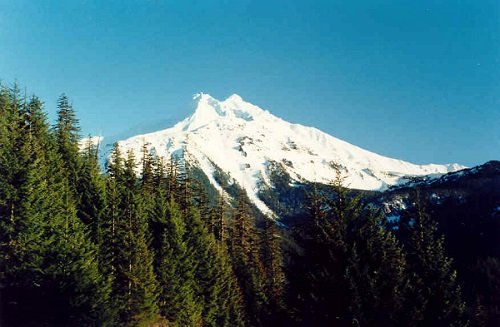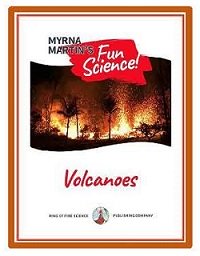What are volcanoes?
the many Different types of volcanoes
Volcanoes come in many shapes and sizes
People often ask what are volcanoes? There is no simple
answer because they come in many shapes and sizes. The most common types are
shield volcanoes, stratovolcanoes and cinder cones.
Shield volcanoes and seamounts
Shield volcanoes form when magma from the upper mantle
collects in magma chambers and then flows out of a volcanic vent onto the
seafloor. The volcanoes range in size from small seamounts to giant shield
volcanoes like Mauna Loa.
Stratovolcanoes
Stratovolcanoes form in subduction zones as towering
volcanoes like Mount Fuji in Japan, Mount Rainier in Washington, and Mount
Spurr in Alaska.
Cinder cones
Cinder cones are small volcanoes that erupt for a short
period of time. The eruptions create a
cone shaped volcano with a crater at its summit.

Stratovolcano in the Pacific Northwest Cascade Mountains
What type of volcanoes form in the oceans
What are volcanoes that form in the oceans. Around the Pacific Ocean where subduction zones occur there is an Andesite Line. Inside the Andesite Line are volcanoes made of basalt in the ocean basin that form shield shaped volcanoes. Scientists estimate there are between 30,000 and 50,000 seamounts in the Pacific Ocean alone that are over 1,000 meters tall. Large shield volcanoes like Mauna Loa have also formed inside the Andesite Line.
Stratovolcanoes on the Continents
What are volcanoes that form outside the Andesite Line in subduction zones. Stratovolcanoes volcanoes form as the subducting ocean plates melt outside the Andesite Line. The molten rock mixes with the continental rocks to form andesite and dacite. The Aleutian Islands are stratovolcanoes on the continental side of the Andesite Line in the North Pacific Ocean. The volcanoes are located on the North American Plate.

I am recommending this book for you to read because it includes information on major types of volcanoes, different types of eruptions, and volcanic rocks produced by the volcanoes . Each chapter also contains a fun activity. Myrna

Click for More Information and to Order
What are Stratovolcanoes?
Stratovolcanoes usually alternate between eruptions of tephra and lava flows that are composed of andesite and dacite. Andesite and dacite are more viscous and cooler than basalt lava.
Explosive eruptions sometimes occur when the pressure inside the volcanoes increases until a violent eruption occurs.
The eruption of Mount Pinatubo in the Philippines is an example of a violent volcanic eruption of a stratovolcano. The explosive eruption occurred on June 15, 1991. The volcano had been dormant for about 500 years and was thought to be extinct.
The eruption of Mount Pinatubo was the second largest eruption of the 20th Century. The eruption was so violent it produced pyroclastic flows, giant mudflows and a large volcanic ash cloud.
How Dacite and lava domes Form
Calderas form after major explosive eruption of stratovolcanoes. Small lava domes form inside the calderas as new lava from the magma oozes out of the volcano's vent. Small lava domes also form above new vents on the slopes of stratovolcanoes.
Dacite is a thick pasty lava that does not flow away from the vent of a volcano. Instead, dacite oozes out like toothpaste from a tube. When the pressure of new lava pushes upward the outer shell of the dacite dome breaks apart as the dome expands causing the collapse of the dome. When the lava dome collapses they create deadly pyroclastic flows on the slopes of the volcano destroying everything in its path.
More Volcano Links
Pyroclastic flows travel at hurricane speeds Find out more about these small crumbly volcanoes that form on the sides of larger volcanoes and in their craters.
Dangerous Alaskan volcanoes Find out more about the Alaskan volcanoes that frequently erupt all along the coast of Alaska.
What are lahars? Find out more about lahars which are triggered by pyroclastic flows, eruptions that can bring death and destruction to people living near volcanoes.
1991 Eruption of Mount Pinatubo Find out more about the second largest volcanic eruption of the 20th century.
Novarupta and Katmai volcanoes Find out more about this Alaskan volcano that was once thought to be the source of the largest volcanic eruption of the 20th century.
Volcanoes create igneous rocks There are four major groups of volcano rocks formed during volcanic eruptions.
Explosive Krakatoa eruption During the Krakatoa Eruption pyroclastic flows swept over the surface of the ocean to other island.
Hawaiian volcanoes are hot spot volcanoes Find out more about the Hawaiian volcanoes which are the largest volcanoes on Earth.
Fun volcano facts Volcanoes are fiery mountains that produce eruptions that can alter the weather sometimes for several years.
Vesuvius destroys Pompeii & Herculaneum The Vesuvius eruption was observed by Pliny the Younger who wrote an eyewitness account of the eruption.
Large & small shield volcanoes The Hawaiian shield volcanoes are the largest volcanoes on Earth.
Supervolcanoes and mega calderas Super volcanoes produce huge amounts of ash and pyroclastic material that can alter the weather for years.
Pyroclastic flows travel at hurricane speeds Pyroclastic flows travel down the flanks of volcanoes at hurricane speed destroying everything in their path.
Loihi is a hot spot seamount Loihi is a seamount growing off the coast of the Big Island of Hawaii. Loihi is the newest member of the Hawaiian Volcanoes
Yellowstone is a supervolcano Yellowstone is a super volcano that has erupted three time in Yellowstone Park in the past 2 million years.
Pyroclastic flows caused by dome volcanoes Dome volcanoes can produce deadly pyroclastic flows when they collapse on the slopes of a stratovolcano.
KIDS FUN Science Bookstore
Check out Myrna Martin's award winning textbooks, e-books, videos and rock sets. The Kids Fun Science Bookstore covers a wide range of earth science topics. Click here to browse.










